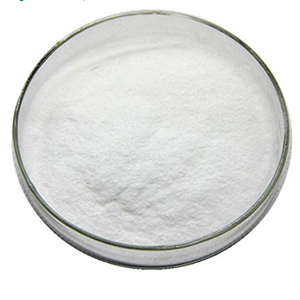
Calcium Glycerophosphate BP Ph Eur
Ph Eur
C3H7CaO6P -- 210.1 -- 27214-00-2
Action and use: Excipient.
DEFINITION
Mixture in variable proportions of the calcium salt of 2,3-dihydroxypropyl phosphate and of 2-hydroxy-1-(hydroxymethyl)ethyl phosphate which may be hydrated.
Content: 18.6 per cent to 19.4 per cent of Ca (dried substance).
CHARACTERS
Appearance: White or almost white powder, hygroscopic.
Solubility: Sparingly soluble in water, practically insoluble in ethanol (96 per cent).
IDENTIFICATION
A. Mix 1 g with 1 g of potassium hydrogen sulphate in a test tube fitted with a glass tube. Heat strongly and direct the white vapour towards a piece of filter paper impregnated with a freshly prepared 10 g/l solution of sodium nitroprusside. The filter paper develops a blue colour in contact with piperidine.
B. Ignite 0.1 g in a crucible. Take up the residue with 5 ml of nitric acid and heat on a water-bath for 1 min. Filter. The filtrate gives reaction of phosphates.
C. It gives reaction of calcium.
TESTS
Solution S: Dissolve 1.5 g at room temperature in carbon dioxide-free water prepared from distilled water and dilute to 150 ml with the same solvent.
Appearance of solution: Solution S is not more opalescent than reference suspension.
Acidity or alkalinity: To 100 ml of solution S add 0.1 ml of phph solution. Not more than 1.5 ml of 0.1 M hydrochloric acid or 0.5 ml of 0.1 M sodium hydroxide is required to change the colour of the indicator.
Citric acid: Shake 5.0 g with 20 ml of carbon dioxide-free water and filter. To the filtrate add 0.15 ml of sulphuric acid and filter again. To the filtrate add 5 ml of mercuric sulphate solution and heat to boiling. Add 0.5 ml of a 3.2 g/l solution of potassium permanganate and again heat to boiling. No precipitate is formed.
Glycerol and ethanol (96 per cent)-soluble substances: Maximum 0.5 per cent. Shake 1.000 g with 25 ml of ethanol (96 per cent) for 1 min. Filter. Evaporate the filtrate on a water-bath and dry the residue at 70C for 1 h. The residue weighs a maximum of 5 mg.
Chlorides: Maximum 500 ppm.
Phosphates: Maximum 400 ppm.
Sulphates: Maximum 0.1 per cent, determined on solution S.
Arsenic: Maximum 3 ppm.
Iron: Maximum 50 ppm, determined on 0.20 g.
Heavy metals: Maximum 20 ppm.
Loss on drying: Maximum 12.0 per cent, determined on 1.000 g by drying in an oven at 150 °C for 4 h.
ASSAY
Dissolve 0.200 g in water. Carry out the complexometric titration of calcium. 1 ml of 0.1 M sodium edta is equivalent to 4.008 mg of Ca.
Calcium Glycerophosphate FCC Food Grade
C3H7CaO6P Formula wt 210.14
CAS: [27214-00-2]
DESCRIPTION
Calcium Glycerophosphate occurs as a fine, white powder. It is somewhat hygroscopic. One gram dissolves in about 50 mL of water at 25C. It is more soluble in water at a lower temperature, and citric acid increases its solubility in water. It is insoluble in alcohol.
Function: Nutrient.
REQUIREMENTS
Identification: A saturated sample solution gives positive tests for Calcium.
Assay: Not less than 98.0% and not more than 100.5% of C3H7CaO6P, after drying.
Alkalinity: Passes test.
Lead: Not more than 4 mg/kg.
Loss on Drying: Not more than 12.0%.